Alaró decks out for the festes
Festes celebrated in Los Damunt and Los Davall have their origin in strongly rooted celebrations of the village. New activities have been included with the passing years, combining perfectly with centuries-old tradition.
January
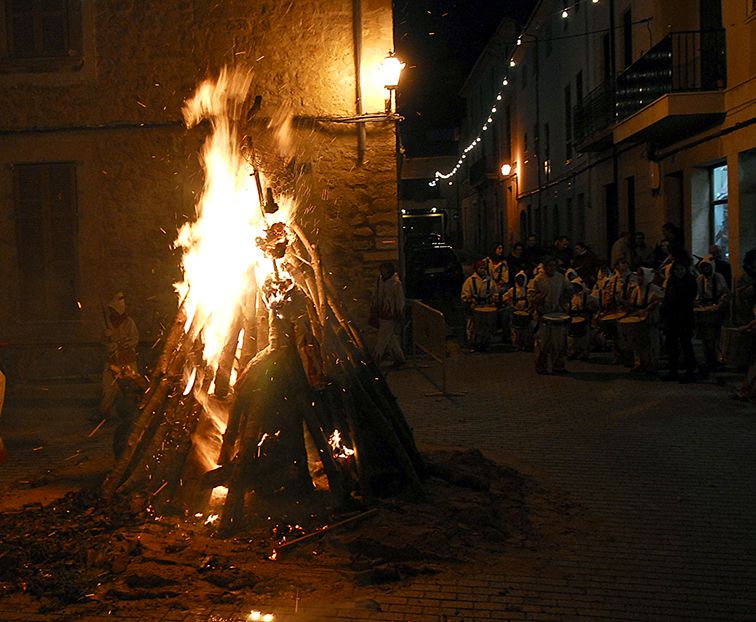
Sant Antoni / January 17th
Sant Antoni Abat, patron saint of animals, is mostly celebrated the night before the festivity. Alaró people roast llonganisses -Catalan dry-cured pork sausage- and botifarres -large Catalan pork sausages- on the countless bonfires, burning happily in the middle of the village streets during the night of January 16th. Just get close to one of them and share your roasted sausages with a glass of wine from the county vineyards. This night is also special for the Colla de Dimonis d'Alaró, which make their first appearance of the year.
Fire as a universal symbol arousing interest and illusion in a chimeric universe is still related to the devil. Performances of the Dimonis d'Alaró started in 1998 with their first correfoc -a restless dance of the devils to the beat of drums under never-ending sparks where watchers are invited to participate.
Na Marranxa is the monstrous figure that comes from the abyss of hell spitting fire and is also the main character of great part of the Dimonis performance. This figure represents a magic and fantastic bat that not long ago, scared the little ones through the tales of their parents. Now, na Marranxa has been recuperated to form part of the popular bestiary of the Dimonis d'Alaró. There is also a children group of Dimonis that organize and reproduce the adult performance: they even have na Marranxeta, a little copy of the monstrous bat. Dimonis perform three times a year in Alaró: at Sant Antoni vigil (16th of January), Sant Roc (16th of August) and at the Fira Gremial (Artisan Fair at the end of September). During the year, they perform around the whole island in fairs, festes and events where they are invited. The festivity of Sant Antoni is announced days before by the picarolada, where younger ones walk around the streets of town ringing cowbells. Sant Antoni characterized as an hermit goes with them and a devil usually chases the group.
On the afternoon of Sant Antoni, the festivity of Ses Beneïdes is celebrated. During this traditional celebration the owners of the pets in town -nowadays taking the place of past times cattle or farm animals- are taken to Sant Bartomeu church where the priest sprinkles them with holy water to protect them against evil during the year.
March / April
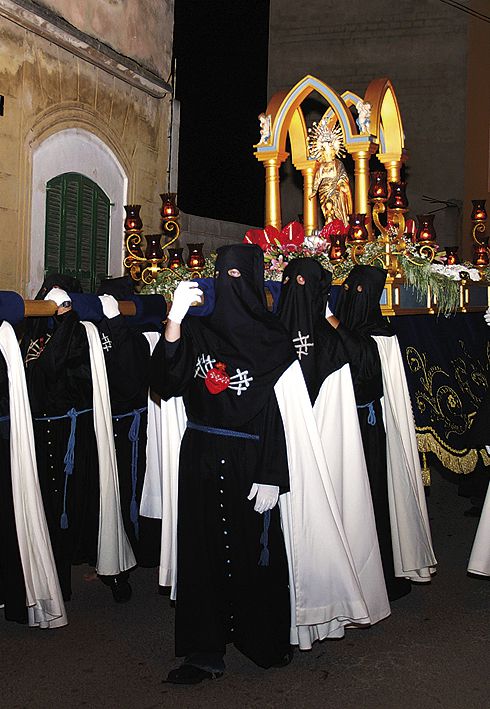
Easter
As it is usual in almost all the country, religious celebrations also enjoy a great acceptance and worship in Mallorca.
Semana Santa is the most important celebration of the Catholic Church consisting of the memorial of the Passion, Death and Resurrection of Jesus Christ. During these days, street processions are carried out with the participation of different religious brotherhoods accompanying pasos of Christ or the Virgin -elaborate floats made for religious processions or parades-, icons related to the passage of the Passion. After Semana Santa, comes the Resurrection on Easter Sunday to celebrate the resurrection of Jesus Christ.
There are five religious brotherhoods in Alaró: Virgen del Refugio, dressed in black and with pita strings; Nuestra Señora de la Esperanza, dressed in green color; el Sagrado Corazón de Jesús, dressed in red color; Virgen de Lourdes, dressed in light blue; and Virgen del Silencio, dressed in black; carrying out a total of four pasos.
Processions are celebrated the nights of Holy Thursday and Holy Friday. On the early morning of Easter Sunday, the Encuentro procession has place in the street junction known as Sa Creu. The Encontre or Encuentro represents the scene where the Virgin meets Christ for the first time after his resurrection. The figures moving around the streets of town are original carvings from the 18th century.
Pancaritat: l'Àngel
The following Sunday after Easter, a pilgrimage to the castle is made by hundreds of people to celebrate the Festa de l'Àngel o la Pancaritat.
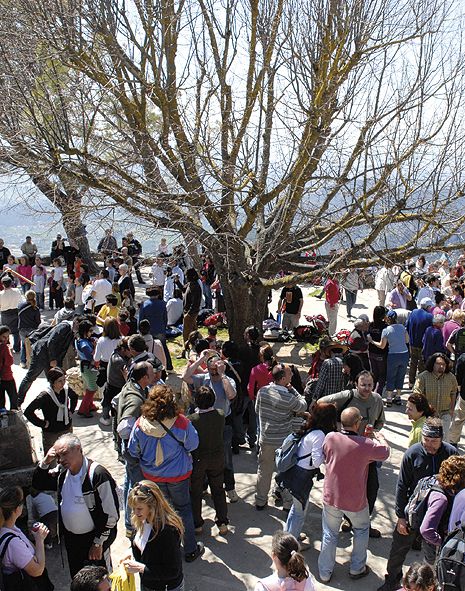
May
Virgin of May
To celebrate the month of Mary, the last Saturday of May, Cossiers dance around the streets of Los Damunt. This group of seven dancers, accompanied by the figure of the Dimoni or Devil, dance around the streets of Los Damunt showing the four traditional dances that have survived over the time.
Traditionally, these performances seem to be half way between dramatization and dance, where the figure of the Dama or Lady has the leading voice and around her, the scene is organized. The performance always finishes with a last act where the devil is finally knocked down to death.
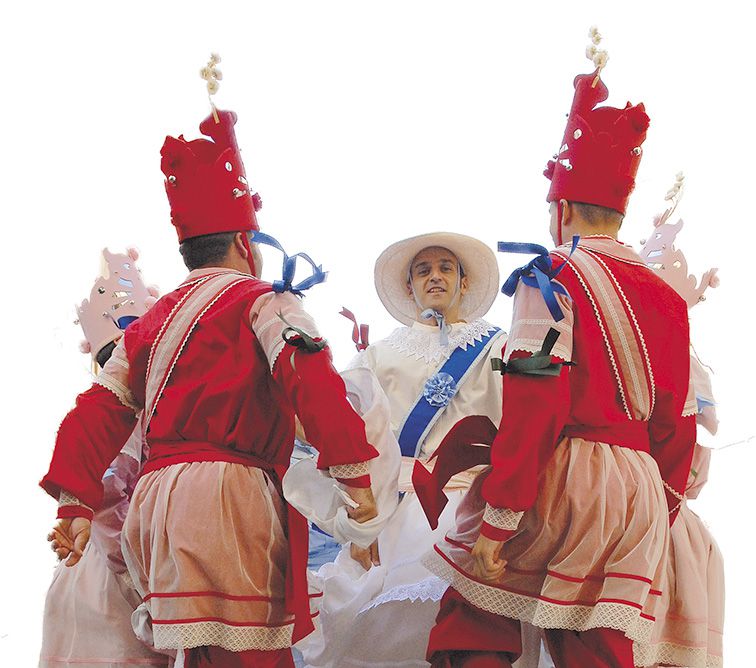
Cossiers dance
Cossiers dance is one of the oldest dances preserved in Mallorca, documented since the 16th century. Archiduc Lluis Salvador described Cossiers in detail during the 19th century in his traveling book titled 'Die Balearem'. There are a large amount of theories about the origin of the word Cossiers, among the most credible we find the one that believes it comes from cós, which means 'a place to run'. Linking to this theory we know that the bands hanging from their girdles were the prizes given in the races, celebrated exclusively for Cossiers in the village cós or arena.
The origin of Cossiers dance is ancient and has been related to archaic dances or ceremonial practices for the worship and cult of agricultural divinities, saving the evident mutations that during the centuries have influenced their clothes, rhythms and organization. Cossiers evolve and coexist with religious manifestations, but they have also been hidden or disguised to secure its permanence during the last centuries. In Alaró, Cossiers dance was recuperated in 1992 after decades of oblivion.
Dancing is performed by six dancers or Cossiers with the Dama or Lady dominating all the dances and movements. The complementary figure of the Cossiers is the Devil: a man dressed up with a sack suit wearing a mask with horns, from which red and yellow bands hang. He distracts people with his jumps, capers and sometimes with knocks of his big stick -without harming the children and adults that are watching the scene.
Cossiers clothes have common elements like bands, bonds, skirts, rope-soled sandals or breast bands, although some of the elements change depending on the town. In Alaró, dancers are organized by couple colors: red, pink and light blue. The hat is a relic from Baroque clothing, commonly used among dancers in past times. It is a kind of crown or cardboard mitre covered with cloth of the same color as the clothes and decorated with little mirrors, bells, flowers and five big pompoms made of wool.
The Lady has been always interpreted by a man with female clothing: a blouse and an organdy skirt with white lace edging and colored bands and ribbons crowned with a straw hat. Before, there were a large number of dances interpreted by Cossiers, but nowadays, only some of them have been recuperated accompanied by two tunes: La Procesión, La Oferta, La Cadena and La Gentil Señora.
Cossiers only perform two times during the year: in the festa of the Virgin of May and on the patron saint day of Sant Roc, the 16th of August. The only way of enjoying the dances and observing closely the particularities and most significative elements of these peculiar dancers is to assist to one of the counted performances of the Cossiers d'Alaró.
June
Sant Pere / June 29th
Patron saint of Los Damunt neighborhood is Sant Pere. During the days preceding the 29th of June, several activities and popular open-air festes are celebrated marking the beginning of summer.
Patron saint of Los Damunt neighborhood is Sant Pere. During the days preceding the 29th of June, several activities and popular open-air festes are celebrated marking the beginning of summer.
August
Sant Roc / August 16th
Les festes patronals d’Alaró tenen lloc la setmana que precedeix el 16 d’agost, dia en el qual es commemora l’eradicació de la pesta del segle XVII per la miraculosa intervenció de sant Roc, que va atendre les pregàries dels feligresos.
Durant una intensa setmana es duen a terme diverses activitats lúdiques i culturals, entre les quals destaquen els balls dels cossiers, les corregudes de joies, les carrosses, la processó religiosa, sortida dels gegants, actuacions dels dimonis, exposicions d’art al carrer o diversos concerts i revetles.
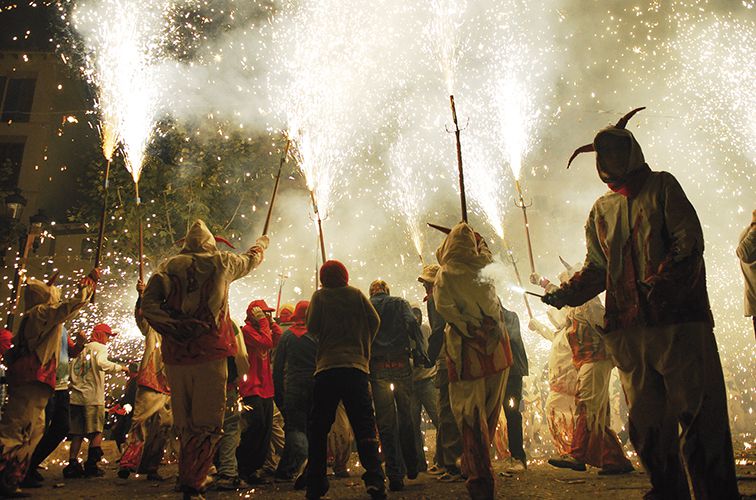
Cossiers i corregudes de joies
Festes of Sant Roc in Alaró are celebrated the week preceding on August 16th, day when the plague was eradicated during the 16th century by the miraculous intervention of Sant Roc after answering parishioners prayers.During this intense week of festes, different ludic and cultural activities are organized such as: Cossiers dances, races -traditionally called Carreres de Joies-, floats -called Carrosses-, processions and performances of the giants Cabrit i Bassa -traditional giant cravings of these two characters of Alaró's history- and the Dimonis, art exhibitions in the street, concerts and open-air celebrations.
Carrosses
Since 1973, the day before San Roc, a traditional parade is celebrated just as if it was a summer carnival. Alaró people dress up and parade in Carrosses -traditional floats- decorated with ludic, vindictive o satiric motifs that make reference to current issues, classics or pure fantasy. After the parade, prizes are awarded to the outstanding participants.
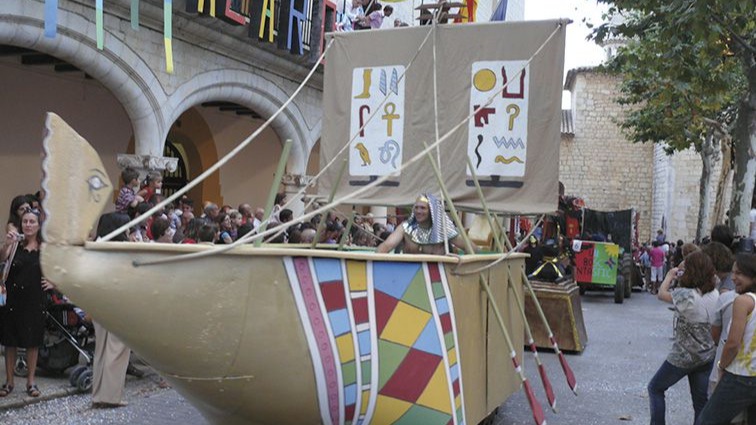
Gegants d’Alaró i Dimonis
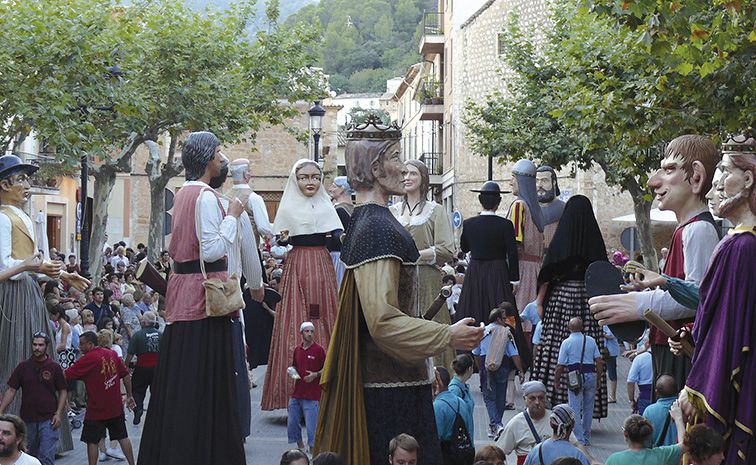
Since the year 2000 two new characters have been incorporated in the festes and celebrations of town: the giants Cabrit and Bassa.
This two figures are more than four meters high and embody the medieval heroes that bravely defended the fortress of the Castell d'Alaró. Giants perform accompanied by the music of flabiol, tamborí and xeremies. They meet at the Plaça de la Vila with other giants or gegants from different towns, being more than thirty figures for children's enjoyment.
Patron Saint's Day ends with a correfoc by the Dimonis d'Alaró at the Plaça de la Vila
September
Nativity of the Blessed Virgin Mary
The first Sunday of September Nativity of the Blessed Virgin Mary is also celebrated with a pilgrimage and a popular meal in front of the Oratory of the Castell d'Alaró.
Fairs and Markets
Weekly markets
Every Saturday morning, the Plaça de la Vila becomes an open-air market where any kind of provisions and artisan products from Alaró are found, as well as other products of recent exhibition like clothes or even flowers and plants.
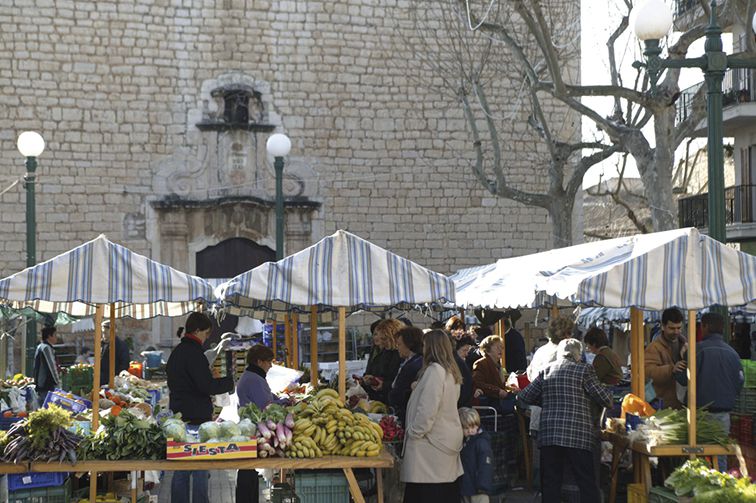
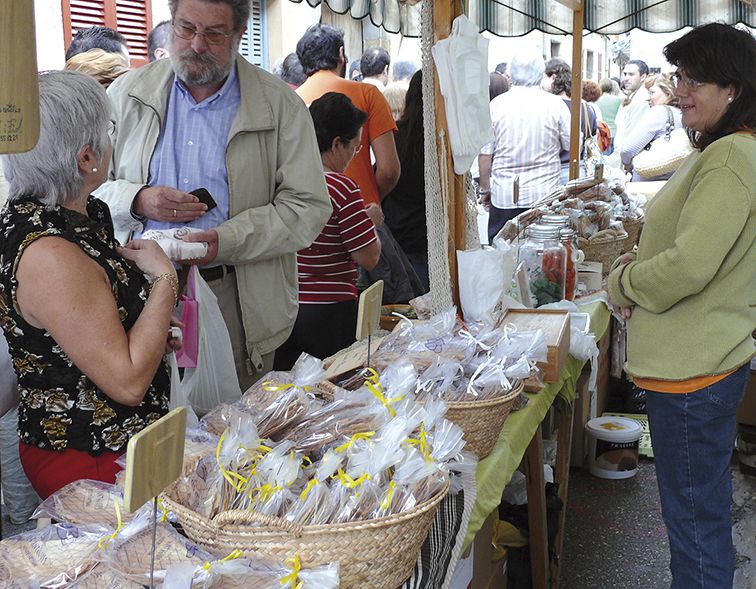
Autumn Artisan's Fair
At the end of September, the Fira d'Artesania gathers together all the different artisan works of Alaró. Last fairs have incorporated all kind of ludic and commercial activities to make a more pleasant and entertaining fair, like the editions of cooking shows and regional wine tasting.